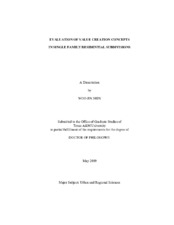| dc.description.abstract | To increase real estate values, developers often apply designs on the land. In the
case of a single family housing development, the designs are applied to the unit of
subdivisions. In this study, the designs are defined as “value creation concepts,” which
increase housing values at the subdivision level. The value creation concepts are
classified into five categories – the sense of arrival, product mix, walkability, circulation
system, and amenity.
This cross-sectional study focuses on exploring the effects of value creation
concepts in the subdivision. Two methodologies – the Hedonic Price Model (HPM) and
the Hierarchical Linear Model (HLM) – are used to test whether or not the value creation
concepts would increase or decrease single family housing values.
The study sample is composed of 6,562 single family houses nested in 85
subdivisions in College Station, Texas. Data are composed of two levels: the housing level and the subdivision level. The scores of the sense of arrival were provided by sixtyone
graduate students at Texas A&M University using photograph evaluations. Most
structural variables were obtained from the Brazos County Appraisal District, and
physical environmental variables were objectively measured using the Geographical
Information System.
In the both models, sense of arrival, greenway connectivity, sidewalk
connectivity, and median length of cul-de-sac variables have positive effects on single
family housing values while phased project, the number of accessible entrances, street
density, single family density, and median length of block variables have negative
effects on single family housing values. At the housing level, several structural variables
(e.g. bathrooms, attached garage, porches, etc), attached to a golf course, sports facilities,
network distance from the nearest elementary school, population density, and personal
variables (i.e., tenure, workable age, employment) were significant (p<.05) predictors of
single family housing value.
Findings support that the value creation concepts have effects on increasing
housing values at the subdivision level, which would provide thoughtful insights for
developers in residential areas. In addition, the HLM can be used as the complement of
the HPM by controlling interaction terms between housing variables and subdivision
variables, or among the subdivision variables themselves. | en |
| dc.subject | Value Creation Concepts, Sense of Arrival, Product mix, Walkability, Circulation System, Amenity, Single Family Residential Development, Subdivision, Hedonic Price Model, Hierarchical Linear Model | en |


